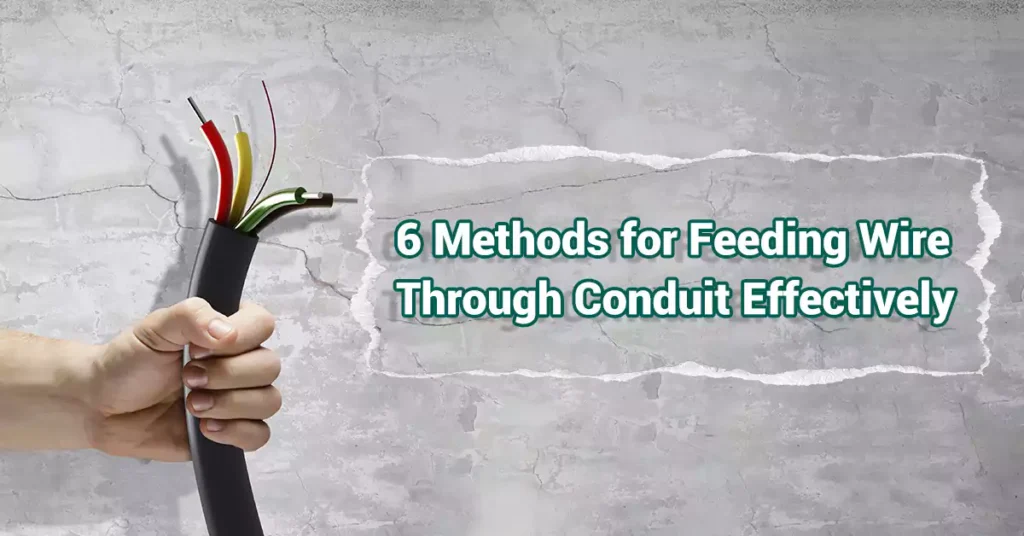
Table des matières
Faire passer des fils dans un conduit est une tâche courante dans les installations électriques, que vous installiez un nouveau bâtiment, des câbles électriques pour des rénovations ou des lignes de communication. Il est essentiel de bien maîtriser ce processus pour garantir la sécurité, la fonctionnalité et la conformité aux normes. L'utilisation de techniques appropriées peut éviter d'endommager le câblage et le conduit tout en minimisant la main-d'œuvre. Cet article présente six méthodes efficaces pour faire passer des fils dans un conduit.
Considérations avant le tirage de câbles
Avant de commencer le processus de tirage de câbles dans un conduit, il est essentiel de se préparer soigneusement. Cela permet non seulement d'éviter toute tension inutile sur les câbles et le conduit, mais également d'éviter des complications telles que des fils cassés ou un dysfonctionnement du système par la suite.
1. Taille et type de conduit :
La taille et le type de conduit (PVC, EMT, flexible) auront un impact significatif sur la facilité de tirage des câbles. Les conduits plus grands peuvent accueillir plus de fils, mais ils nécessitent également plus de force pour tirer les fils. Il est essentiel de comprendre les directives du National Electrical Code (NEC) sur le remplissage des conduits pour éviter la surchauffe et garantir la conformité.
2. Type et taille du fil :
Différents types de fils (THHN, NM, etc.) présentent différents niveaux de flexibilité et de rigidité. Les fils de plus gros calibre peuvent être plus difficiles à tirer, en particulier sur des longueurs plus longues. Il est essentiel de sélectionner le fil approprié pour l'application prévue.
3. Longueur et itinéraire du conduit :
La longueur du conduit et les éventuels coudes ou virages auront une incidence sur le processus de tirage. Plus le conduit comporte de coudes, plus il sera difficile de tirer le fil. Planifier le trajet avec le moins de virages possible facilitera le tirage du fil.
4. Conditions environnementales :
Des facteurs tels que la température, l'humidité et la présence de poussière ou d'humidité peuvent affecter à la fois le fil et le processus de tirage. Par exemple, une humidité élevée peut faire coller les fils ensemble, ce qui les rend plus difficiles à tirer.
5. Outils et équipements :
Il est essentiel d'avoir les bons outils à portée de main. Cela comprend des tire-fils, des lubrifiants et des équipements de sécurité. Évaluer à l'avance les outils nécessaires pour le travail peut vous faire gagner du temps et éviter les complications.
Un matériau important : les lubrifiants
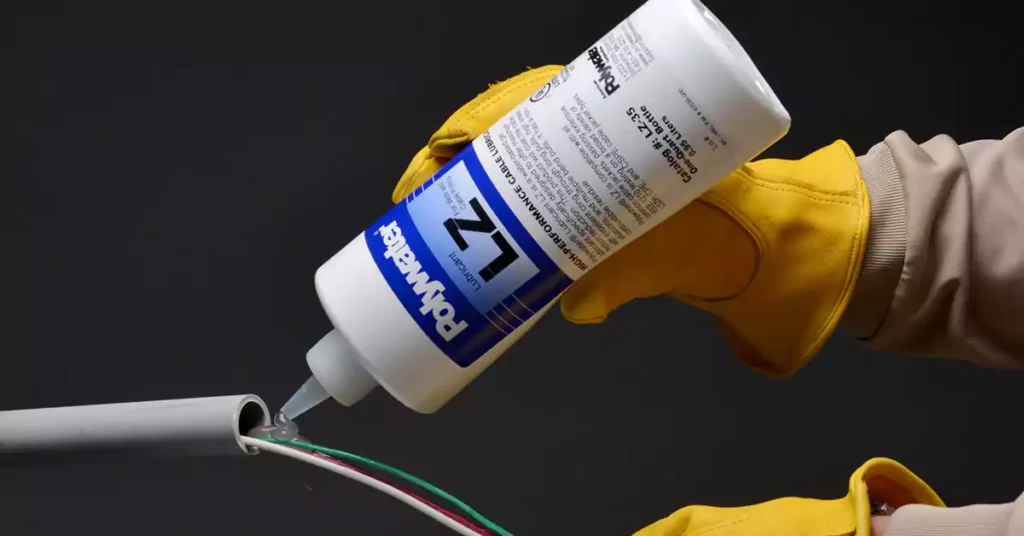
Les lubrifiants pour tirage de fil (souvent appelés lubrifiants pour fil ou lubrifiants de tirage) jouent un rôle essentiel dans la réduction du frottement entre le fil et le conduit. Lorsque vous tirez un fil sur de longues distances ou dans un conduit comportant plusieurs coudes, des frottements peuvent s'accumuler, ce qui rend difficile le tirage en douceur du fil. Les lubrifiants permettent de garantir que le fil glisse facilement, le protégeant ainsi des dommages.
a. Types de lubrifiants :
Il existe deux principaux types de lubrifiants pour tirage de fils : à base d'eau et à base de cire.
- Lubrifiants à base d'eau : Ce sont les lubrifiants les plus couramment utilisés. Ils sont faciles à nettoyer, respectueux de l'environnement et fonctionnent bien dans une large plage de températures.
- Lubrifiants à base de cire : Ceux-ci sont plus épais et peuvent être nécessaires dans des conditions plus extrêmes, comme les environnements chauds ou froids. Les lubrifiants à base de cire résistent mieux au dessèchement au fil du temps, ce qui est utile pour les applications à long terme.
b. Comment appliquer le lubrifiant pour fil :
Appliquez généreusement du lubrifiant sur le fil avant de commencer la traction. Veillez à enduire le fil uniformément et à appliquer davantage de lubrifiant au point d'entrée du conduit pour minimiser la résistance. Si la traction est particulièrement longue ou difficile, vous pouvez faire une pause à mi-chemin pour ajouter plus de lubrifiant au fil.
6 façons de tirer le fil à travers un conduit
Il existe plusieurs techniques différentes pour tirer des câbles dans des conduits, et la meilleure pour vous dépendra de la longueur du parcours, du type de câble et de l'équipement disponible. Ci-dessous, nous explorons six méthodes courantes utilisées pour tirer des câbles :
● Tirage manuel
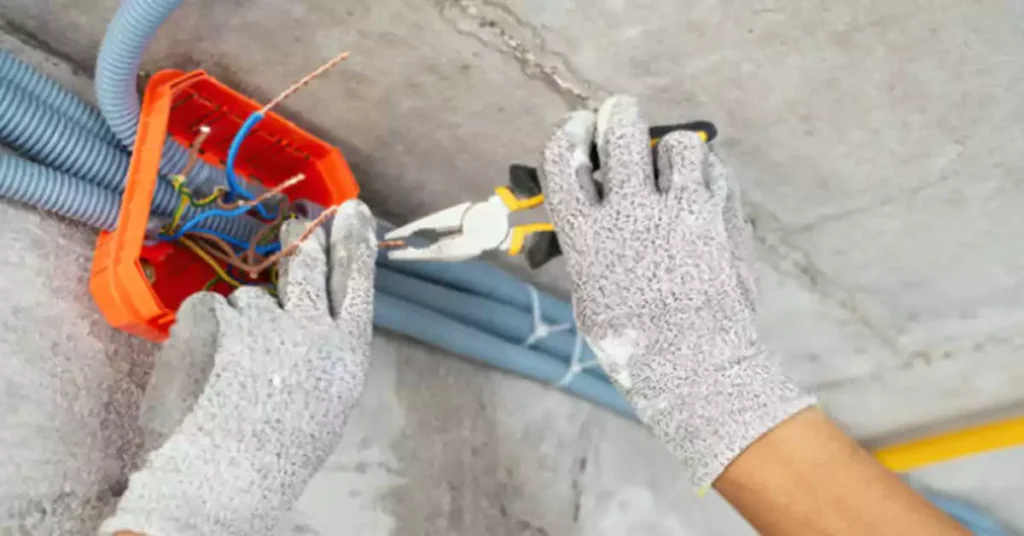
Le tirage manuel est la méthode la plus simple et la plus directe, mais elle n'est généralement utilisée que pour des trajets courts et droits. Cette méthode consiste à introduire le fil dans le conduit à la main tout en le guidant pour minimiser la friction et la résistance.
5 étapes pour le tirage manuel :
- Préparez le conduit : Inspectez le conduit pour détecter tout débris ou bord tranchant qui pourrait endommager le fil. Nettoyez l'intérieur du conduit si nécessaire pour assurer une traction en douceur.
- Lubrifier le fil : Appliquez généreusement du lubrifiant pour tirage de fil sur le fil pour réduire la friction et faciliter le tirage à travers le conduit. Enduisez à la fois le fil et le point d'entrée du conduit.
- Nourrissez le fil : Commencez à introduire lentement le fil dans le conduit, en le guidant pour éviter qu'il ne s'emmêle. Une personne peut introduire le fil pendant qu'une autre tire depuis l'extrémité opposée.
- Maintenir une tension constante : La personne qui tire le fil doit appliquer une pression uniforme et constante pour éviter les pliures ou les courbures. Si vous sentez une résistance, arrêtez-vous et ajustez pour éviter d'endommager l'isolation du fil.
- Terminez le tirage : Une fois le fil passé, vérifiez qu'il ne présente aucun signe de dommage, comme des entailles ou des coupures. Assurez-vous que le fil a suffisamment de mou aux deux extrémités pour effectuer les connexions électriques nécessaires.
Le tirage manuel est idéal pour les petits tirages ou lorsqu'aucun outil spécialisé n'est disponible. Cependant, pour les tirages plus longs ou plus complexes, cette méthode peut être physiquement exigeante et moins efficace.
● Tirer un fil avec une souris
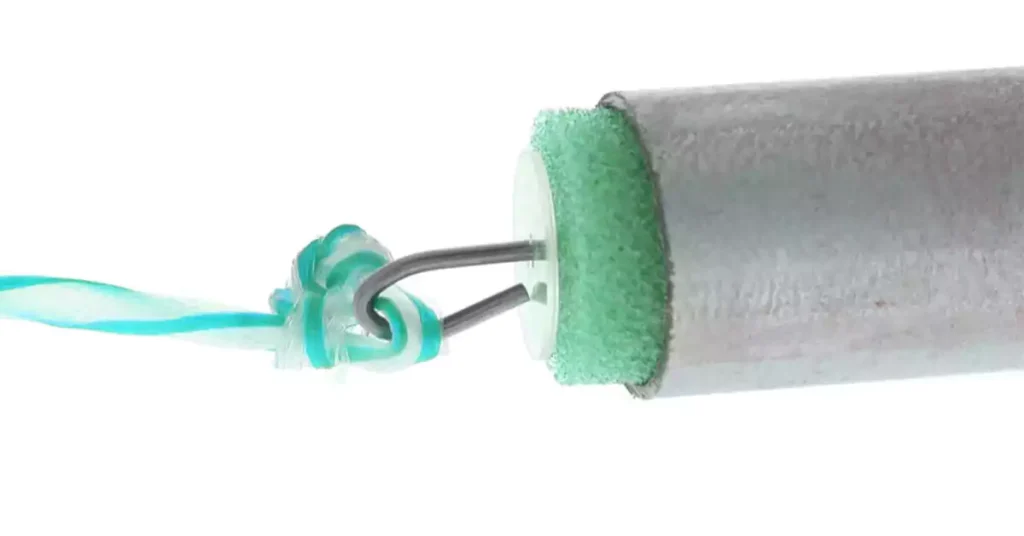
L'utilisation d'une souris est une méthode très efficace pour les parcours de longueur moyenne, notamment ceux comportant des virages. La souris, un petit appareil généralement en mousse ou en caoutchouc, est poussée à travers le conduit par de l'air comprimé, tirant sur une ficelle qui sert ensuite à tirer le fil.
5 étapes pour tirer un fil avec une souris :
- Sélectionnez la souris : Choisissez une souris qui s'insère parfaitement dans le conduit sans être trop serrée. La souris doit créer suffisamment de résistance pour être poussée par l'air, mais pas au point de rester coincée.
- Attachez le cordon de traction : Attachez solidement une ficelle à la souris à l'aide d'un nœud solide. Assurez-vous que la ficelle est suffisamment longue pour atteindre l'autre extrémité du conduit.
- Configurer le souffleur d'air : Insérez la buse du souffleur d'air dans le conduit, en vous assurant que le joint est étanche pour maximiser la pression d'air. Allumez le souffleur et poussez la souris à travers le conduit.
- Récupérer la souris et la chaîne : Une fois que la souris sort de l'autre extrémité du conduit, récupérez la ficelle et la souris. Détachez la souris et vérifiez que la ficelle ne présente aucun nœud.
- Tirez sur le fil : Attachez le fil à la corde de traction et tirez-le à travers le conduit, en appliquant du lubrifiant pour fil si nécessaire pour un mouvement plus fluide.
Cette méthode est efficace pour les parcours moyens à longs, en particulier dans les conduits avec des coudes, car la pression de l'air aide la souris à naviguer dans les courbes serrées.
● Tirage de fil avec une ficelle
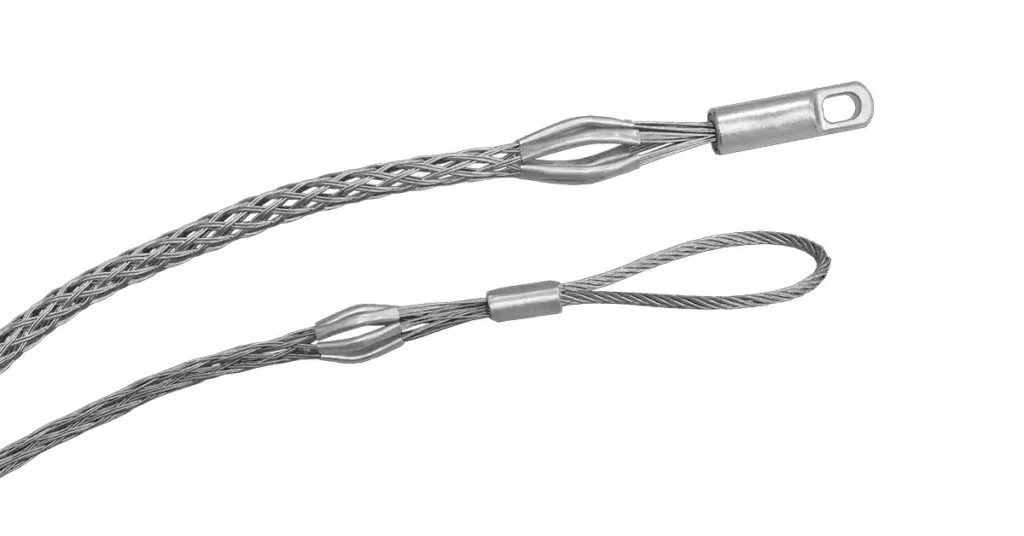
Le tirage de câbles à l'aide d'une ficelle est une méthode simple adaptée aux courts trajets ou aux conduits avec des courbures limitées. La ficelle est soit introduite manuellement, soit soufflée à travers le conduit, puis utilisée pour tirer le câble.
5 étapes pour tirer un fil avec une ficelle :
- Insérer la chaîne : Vous pouvez introduire manuellement la corde dans le conduit ou utiliser la pression d'air (comme avec la souris) pour la faire passer. Assurez-vous que la corde est suffisamment longue pour atteindre toute la longueur du conduit.
- Fixez le fil à la corde : Une fois que la corde atteint l'autre extrémité, attachez-y solidement le fil. Utilisez du ruban isolant pour rendre la connexion lisse et éviter qu'elle ne s'accroche aux points rugueux à l'intérieur du conduit.
- Appliquer le lubrifiant : Pour des tirages plus longs, appliquez du lubrifiant sur le fil et sur le point d'entrée du conduit pour réduire la friction.
- Tirez sur le fil : Tirez doucement sur la corde pour guider le fil à travers le conduit. Appliquez une tension constante pour éviter les pliures ou les accrocs. Si vous rencontrez une résistance, arrêtez-vous et ajustez pour éviter d'endommager le fil.
- Terminer la traction : Une fois que le fil est complètement passé dans le conduit, détachez-le de la corde et inspectez-le pour déceler tout dommage. Assurez-vous qu'il y a suffisamment de fil aux deux extrémités pour effectuer vos connexions.
Le tirage de fil avec une ficelle est une méthode simple et économique, particulièrement utile pour les parcours courts et droits ou lorsque d'autres outils ne sont pas disponibles.
● Tirage de fil avec du ruban de poisson
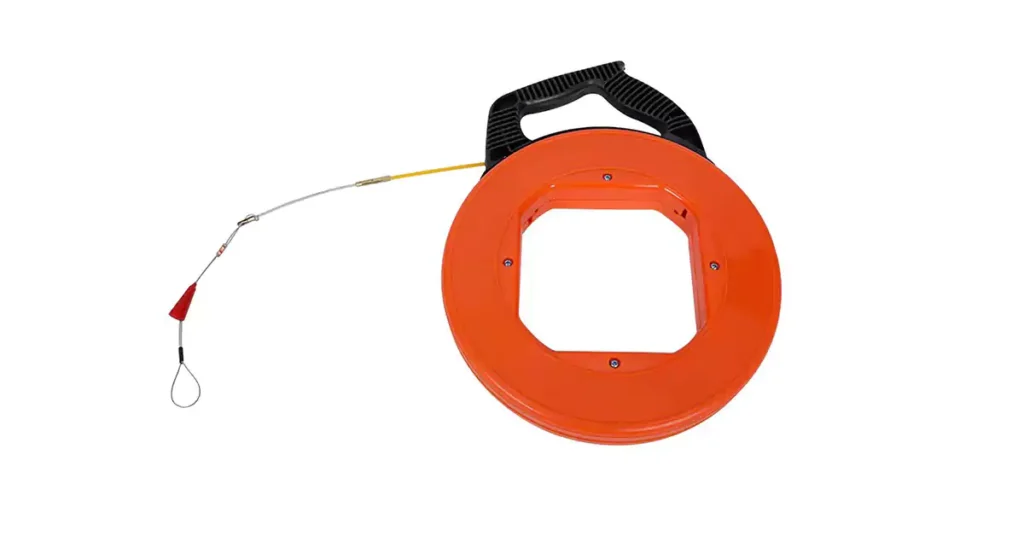
Le ruban de tirage est un outil couramment utilisé pour tirer les fils à travers les conduits, en particulier dans les cas où le parcours est long ou comporte des coudes. Il s'agit d'un ruban fin et flexible en acier ou en fibre de verre qui est poussé à travers le conduit, puis utilisé pour tirer le fil vers l'arrière.
5 étapes pour tirer des fils avec du ruban de tirage :
- Ruban pour nourrir les poissons : Commencez par insérer le ruban de tirage dans une extrémité du conduit. Poussez lentement le ruban à travers le conduit, en utilisant sa flexibilité pour contourner les coudes. Continuez à pousser jusqu'à ce que le ruban de tirage atteigne l'autre extrémité.
- Attachez le fil : Une fois le ruban de tirage passé, fixez le fil à la boucle située à l'extrémité du ruban. Utilisez du ruban isolant pour fixer fermement le fil et créer une transition en douceur pour éviter les accrocs.
- Lubrifier le fil : Si le parcours est long ou comporte plusieurs virages, appliquez du lubrifiant pour fil afin de réduire la friction et de faciliter la traction.
- Tirez sur le fil : Retirez le ruban de tirage en tirant le fil à travers le conduit. Appliquez une pression constante et guidez le fil pendant qu'il se déplace. Si vous rencontrez une résistance, faites une pause et appliquez davantage de lubrifiant.
- Terminer la traction : Une fois le fil passé, détachez-le du ruban de tirage et inspectez-le pour détecter tout dommage.
Le ruban de poisson est très efficace pour les courses longues ou compliquées et constitue un outil polyvalent qui peut être réutilisé pour plusieurs projets.
● Tirage de fil avec un poids de pêche
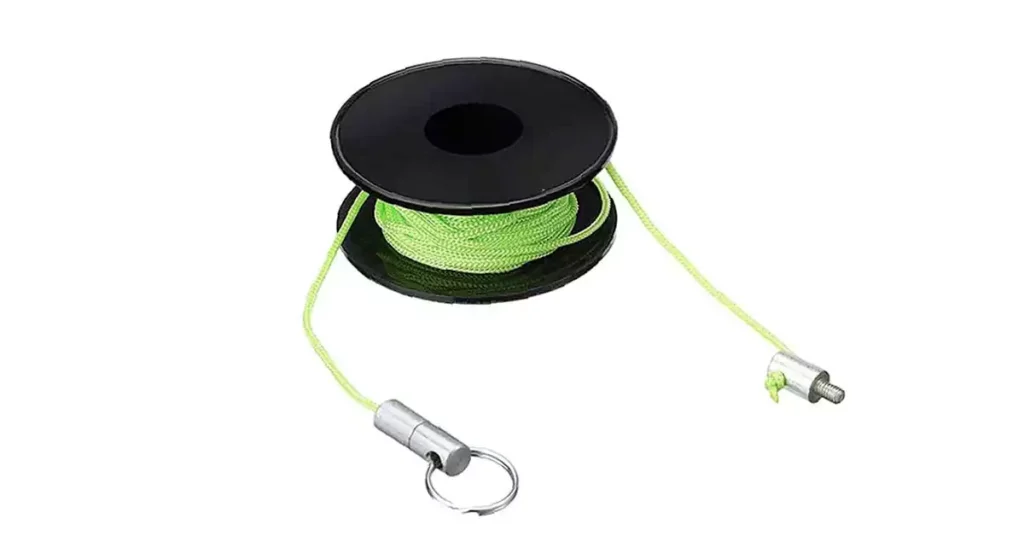
Un poids de pêche peut être utilisé pour tirer un fil à travers un conduit par gravité, en particulier dans les conduits verticaux ou inclinés. Un poids est attaché à une corde et la gravité aide à tirer la corde à travers, qui est ensuite utilisée pour tirer le fil.
5 étapes pour tirer un fil avec un poids de pêche
- Attachez le poids à la corde : Fixez un poids de pêche petit mais lourd à l'extrémité d'une corde de traction. Assurez-vous que la corde est suffisamment longue pour atteindre le fond du conduit.
- Déposez le poids dans le conduit : Insérez le poids dans la partie supérieure du conduit et laissez la gravité le tirer vers le bas. Pour les parcours horizontaux ou en pente, vous devrez peut-être secouer doucement le conduit pour faciliter le déplacement du poids.
- Récupérer le poids : Une fois que le poids atteint le fond, récupérez-le avec la corde de traction à l’autre extrémité du conduit.
- Attachez le fil à la ficelle : Attachez solidement le fil au cordon de traction, en utilisant du ruban électrique pour assurer une connexion fluide.
- Tirez sur le fil : Tirez la ficelle depuis l'extrémité opposée, en introduisant le fil dans le conduit pendant que vous tirez. Appliquez du lubrifiant pour fil si nécessaire pour faciliter la traction.
Cette méthode est simple mais efficace pour les conduits verticaux ou légèrement inclinés où la gravité peut aider à tirer la corde.
● Tirage de fil avec une machine de tirage
Pour les longs trajets ou les tracés de conduits particulièrement difficiles, une machine de traction peut être utilisée. Ces machines appliquent une force de traction constante sur le fil, ce qui les rend idéales pour les trajets longue distance ou complexes avec de nombreux coudes.
5 étapes pour tirer des fils avec une machine à tirer
- Configurer la machine à tirer : Positionnez la machine de tirage à une extrémité du conduit. Assurez-vous que la machine est correctement alignée pour éviter d'endommager le fil.
- Nourrir le poisson avec du ruban ou de la ficelle : Avant d'utiliser la machine, introduisez un ruban de pêche ou une ficelle de traction dans le conduit, soit manuellement, soit à l'aide d'une souris ou d'un poids de pêche.
- Attachez le fil : Fixez le fil au ruban de tirage ou à la ficelle. Vérifiez que la connexion est solide et fluide, car la machine à tirer exercera une force importante sur celui-ci.
- Activer la machine à tirer : Démarrez la machine et laissez-la tirer le fil à travers le conduit. Surveillez attentivement la traction pour vous assurer que le fil ne s'accroche pas ou ne s'abîme pas pendant le processus.
- Terminez le tirage : Une fois le fil passé, éteignez la machine, détachez le fil du ruban de poisson ou de la ficelle et inspectez-le pour détecter tout dommage.
Les machines de traction sont très efficaces pour les séries longues ou complexes, mais sont généralement utilisées dans des projets commerciaux ou industriels en raison de leur taille et de leur coût.
5 conseils pour tirer des câbles en toute sécurité
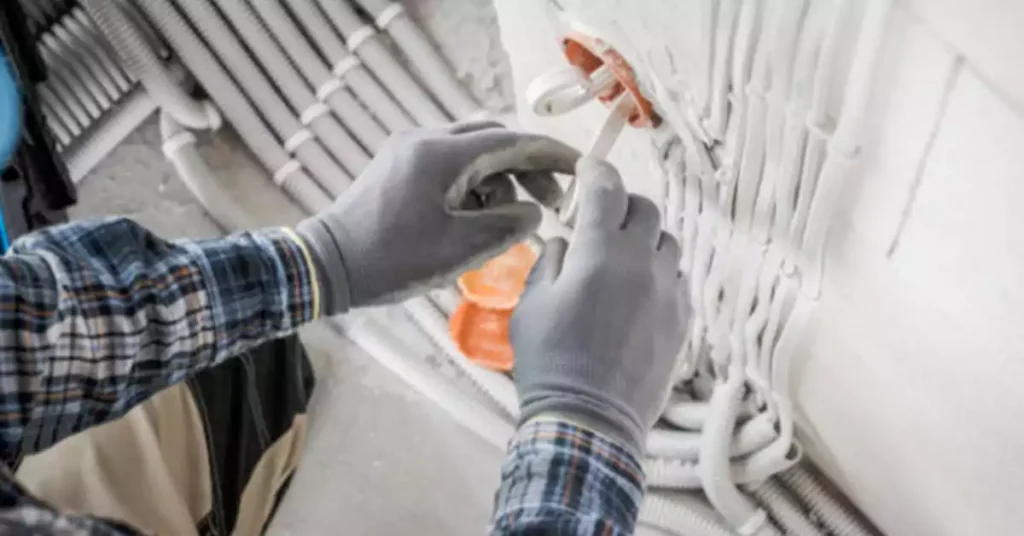
Tirer des câbles en toute sécurité est essentiel pour éviter les dommages, garantir une installation électrique fiable et protéger tous les intervenants. Qu'il s'agisse d'un petit projet domestique ou d'un gros projet commercial, il est essentiel de suivre les mesures de sécurité et de se conformer aux codes électriques. Voici un guide simplifié sur la façon de tirer des câbles en toute sécurité.
a. Respecter les codes électriques
Avant de commencer, assurez-vous que votre processus de tirage de fil suit les Code national de l'électricité (NEC) ou les réglementations locales. Ces codes sont là pour garantir la sécurité et une installation correcte. Points clés à retenir :
- Types de fils corrects : Utilisez des fils approuvés pour une utilisation dans des conduits, tels que THHN ou XHHW, selon votre projet.
- Limites de remplissage des conduits : Ne remplissez pas trop le conduit. Il existe des règles spécifiques concernant le nombre de fils qui peuvent passer en toute sécurité dans un conduit pour éviter toute surchauffe.
- Taille et courbures appropriées des conduits : Assurez-vous que le conduit est de la bonne taille pour les fils et qu'il ne comporte pas trop de coudes serrés, ce qui peut rendre le tirage difficile et endommager le fil.
b. Portez un équipement de protection individuelle (EPI)
L'utilisation d'un équipement de protection adapté vous permet de travailler en toute sécurité. Les EPI importants pour le tirage de câbles comprennent :
- Gants: Protégez vos mains des coupures et des abrasions.
- Lunettes de sécurité : Protégez vos yeux de la poussière, des débris ou du lubrifiant.
- Bottes de travail : Portez des bottes conçues pour la sécurité électrique afin de vous protéger contre les chocs électriques.
c. Planifier et vérifier le conduit
Avant de tirer les fils, prenez le temps de planifier :
- Inspectez le conduit : Assurez-vous que le conduit est exempt de tout blocage, de bords tranchants ou de débris susceptibles d'endommager le fil. Nettoyez-le si nécessaire.
- Tenir compte des virages : Déterminez le nombre de coudes ou d'obstacles présents dans le conduit. Les coudes peuvent augmenter la résistance, il faudra donc peut-être ajouter davantage de lubrifiant.
- Calculer la tension de traction : S'il s'agit d'une longue course, assurez-vous de connaître les limites de tension de traction du fil pour éviter de l'étirer ou de l'endommager.
d. Surveillez la tension pendant la traction
Une force de traction trop importante peut endommager le fil. Pour éviter cela :
- Utiliser une jauge de tension : Si vous utilisez une machine de traction, surveillez la tension pour rester dans les limites de sécurité du fil.
- Arrêter et ajuster : Si vous sentez une résistance, ne forcez pas. Arrêtez, appliquez plus de lubrifiant ou ajustez le fil pour éviter d'endommager l'isolant.
e. Évitez de trop remplir le conduit
Le remplissage excessif du conduit avec trop de fils peut entraîner une surchauffe et des dommages. Suivez ces règles simples :
- Vérifiez les limites de remplissage des conduits : Consultez le NEC ou les codes locaux pour savoir combien de fils peuvent s'insérer en toute sécurité dans le conduit en fonction de sa taille.
- Laissez de la place pour la circulation de l’air : Les câbles ont besoin d'espace pour que l'air puisse circuler et dissiper la chaleur. Trop de câbles entassés dans un conduit peuvent créer un risque d'incendie
En laissant suffisamment d’espace dans le conduit, vous assurez la sécurité et évitez la surchauffe.
Comment calculer le remplissage d'un conduit ?
Le calcul du remplissage des conduits est essentiel pour garantir que l'installation électrique est sûre, efficace et conforme aux normes. Le remplissage excessif d'un conduit peut entraîner une surchauffe, des difficultés de tirage des fils et même des risques d'incendie potentiels. Les codes électriques comme le Code national de l'électricité (NEC) ou le Code canadien de l'électricité (CCE) spécifier le nombre maximal de fils et la section totale des fils qui peuvent être installés en toute sécurité dans un conduit.
Pourcentages maximum de remplissage des conduits :
Nombre de conducteurs | Tous types de conducteurs |
1 | 53% |
2 | 31% |
Plus de 2 | 40% |
Pourquoi est-ce important ?
- Empêche la surchauffe : Un remplissage excessif crée une accumulation de chaleur excessive, ce qui peut endommager l'isolation des fils et présenter des risques pour la sécurité.
- Assure un tirage de fil plus facile : Un espace adéquat à l’intérieur du conduit réduit la friction, ce qui facilite le tirage des fils sans les endommager.
- Maintient la conformité au code : Les calculs de remplissage suivants vous permettent de respecter les normes de sécurité et d’éviter les pénalités.
Le pourcentage de remplissage varie en fonction du type de conduit et du nombre de fils. Pour obtenir des spécifications exactes et des instructions étape par étape sur la façon de calculer le remplissage du conduit, reportez-vous à notre précédent Tableau de remplissage des conduits en PVC. Consultez toujours le NEC ou le CEC pour connaître les normes les plus précises et applicables dans votre région.
Combien de temps durent les conduits électriques ?
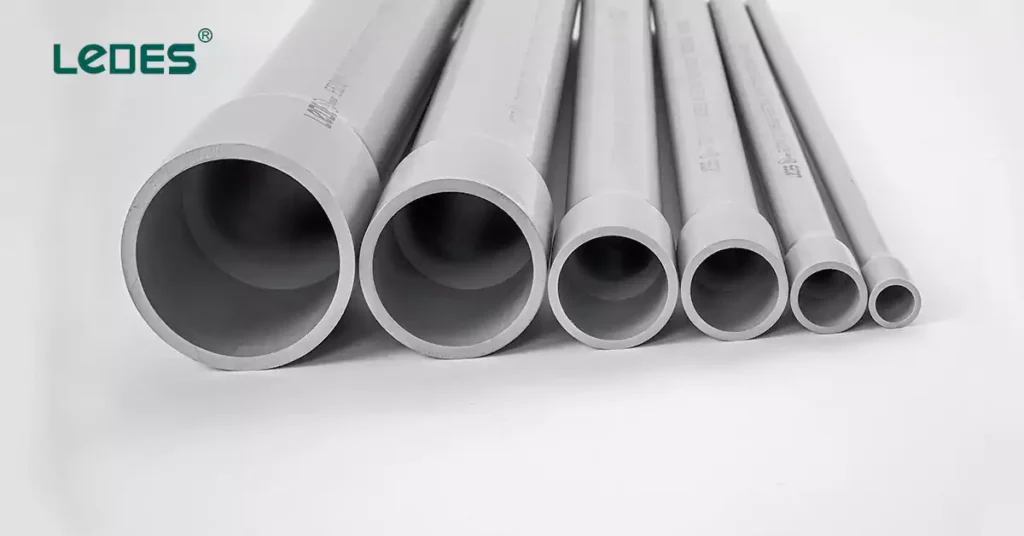
La durée de vie des conduits électriques peut varier en fonction du matériau utilisé, de l'environnement d'installation et de la maintenance. Les matériaux de conduits courants comprennent le PVC, l'acier galvanisé et les conduits métalliques flexibles (FMC). Voici une idée générale de la durée de vie des conduits :
- Conduits en PVC peut durer des décennies, avec une durée de vie typique de plus de 50 ans. Il résiste à l'humidité, à la corrosion et aux rayons UV, ce qui le rend idéal pour les installations extérieures et souterraines.
- Conduit en acier galvanisé (comme les conduits métalliques rigides ou EMT) sont très durables, en particulier dans les environnements sujets aux dommages physiques ou à l'exposition aux produits chimiques. Ils peuvent durer jusqu'à 50 ans ou plus, mais peuvent se corroder dans des environnements difficiles si le revêtement protecteur s'use.
- Conduit métallique flexible (FMC) est plus sujet à l'usure et peut nécessiter un remplacement plus tôt, d'une durée de vie généralement d'environ 20 à 30 ans selon les conditions d'utilisation.
Des inspections régulières et une installation appropriée peuvent contribuer à prolonger la durée de vie du système de conduits, garantissant ainsi la sécurité et la longévité du câblage électrique qu'il protège.
Conclusion
L'alimentation efficace d'un fil dans un conduit nécessite des méthodes, des outils et une planification minutieuse pour éviter d'endommager le fil ou le conduit. Qu'il s'agisse de techniques manuelles, d'outils comme du ruban de tirage ou même de machines de tirage, chaque méthode a ses avantages et ses applications uniques en fonction de la complexité du travail. La sécurité est toujours une priorité absolue, alors assurez-vous que vos pratiques de tirage de câbles respectent les codes électriques, utilisez un équipement de sécurité approprié et planifiez correctement les virages, les obstacles ou les longs tirages.
En comprenant les différentes méthodes disponibles (tirage manuel, utilisation d'une ficelle, d'une souris, d'un ruban de tirage, d'un poids de pêche ou d'une machine de tirage), vous pouvez optimiser le processus de tirage des câbles pour les projets de petite et de grande envergure. De plus, connaître la durée de vie des conduits et l'importance des calculs de remplissage des conduits garantira des installations sûres et à long terme. En suivant ces meilleures pratiques, vous pouvez améliorer l'efficacité, réduire les risques de dommages et assurer le bon fonctionnement de vos systèmes électriques pendant des années.



